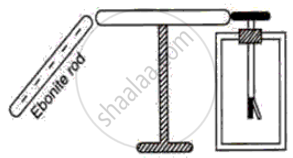Advertisements
Advertisements
प्रश्न
उत्तर
(a) Primary cells cannot be charged again while secondary cells can be charged again and again.
(b) In primary cells, a chemical reaction is irreversible while in secondary cells, a chemical reaction is reversible.
APPEARS IN
संबंधित प्रश्न
Name one D.C. source and one A.C. source.
State and define the S.I. unit of potential difference.
How is the current flowing in a conductor changed if the resistance of conductor is doubled keeping the potential difference across it the same?
A current 0.2 A flows in a wire of resistance 15Ω. Find the potential difference across the ends of the wire.
There is a positively charged sphere A and negatively charged sphere B, such that they are brought in electrical contact by a copper wire.
What is the potential of the spheres after electrical contact?
What do you understand by the term series circuit?
The following figure shows a metal rod PQ mounted on an insulated stand. The cap of an uncharged electroscope touches one end Q of the metal rod. A negatively charged ebonite rod is brought near the other end P of the metal rod.

(a) What charge does the end P have?
(b) What charge does the end Q have?
(c) What charge does the cap of the electroscope have?
(d) What charge does the gold leaf have?
(e) Will the leaf diverge or collapse? Give reason.
(f) If the electroscope is now earthed, what charge does the metal rod have?
State three factors on which the resistance of a wire depends. Explain, how does the resistance depend on the factors stated by you.
A wire of resistance 1 Ω is stretched to double its length. What will happen to the resistance of the stretched wire?
